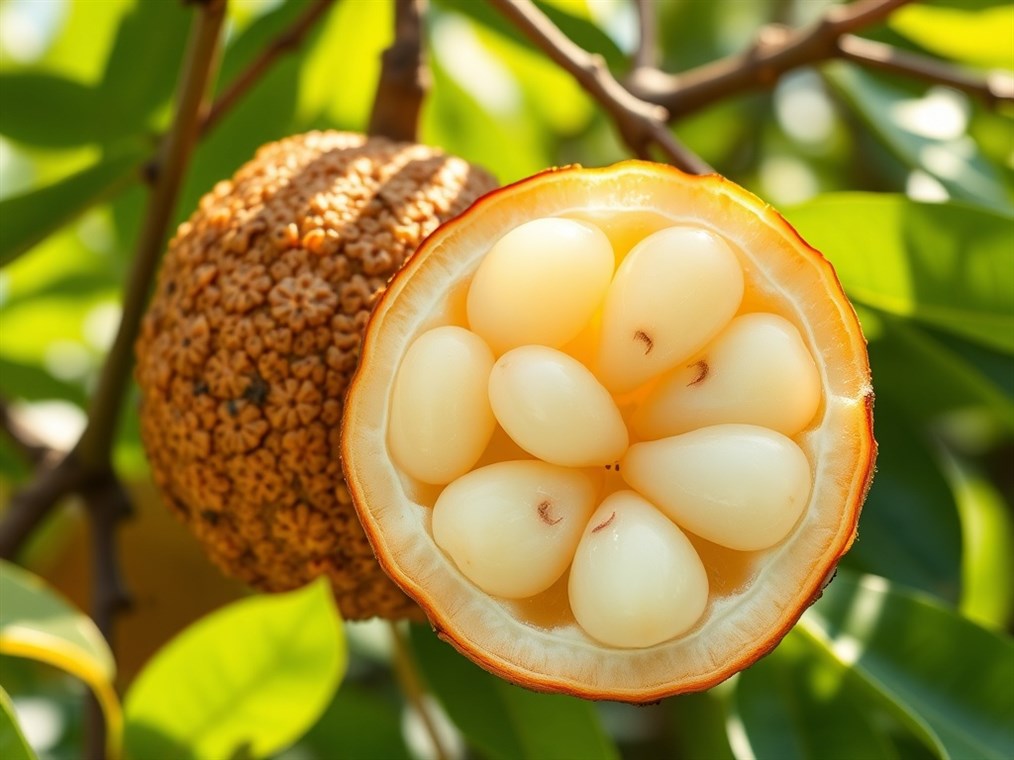Longan: Unveiling the “Dragon’s Eye” – A Guide to this Exotic Fruit
Okay, so you’ve probably seen these little brownish fruits popping up at the market, maybe even wondered what they are. Well, that’s likely a longan! Officially, it’s Dimocarpus longan, but most folks just call it longan. But what is it, really? Let’s dive in and explore this intriguing fruit, also known as the “dragon’s eye.”
What is Longan?
Longan comes from a tree in the soapberry family – yeah, the same family as lychee and rambutan! Think of it as lychee’s less flamboyant cousin. These trees originally hail from tropical Asia, somewhere between Myanmar and Southern China. They’ve been grown for ages in places like Thailand, Vietnam, and Taiwan. We’re talking way back – the earliest records go all the way back to the Han Dynasty, over 2000 years ago!
The fruit itself? Picture a large grape. It’s got a thin, tan shell that peels off super easily. Inside, the flesh is translucent white, sweet, and has this slightly musky flavor. Some say it reminds them of dates. And right in the center, there’s a shiny black seed staring back at you.
“Dragon’s Eye”: The Story Behind the Name
Here’s where it gets cool. The nickname “dragon’s eye” isn’t just some marketing gimmick. It’s all about what the fruit looks like when you peel it. Seriously, peel one and take a look! That translucent white flesh surrounding the round, black seed? It really does look like an eyeball! And get this: in Chinese, the name longan (龍眼/龙眼) literally translates to “dragon eye.” Pretty neat, huh?
Other Names for Longan
“Longan” and “dragon’s eye” are the usual suspects in English, but this fruit has a whole passport full of aliases! You might also hear it called:
- Lungan: Just a different way to spell it, really.
- Euphoria Fruit: Haven’t heard this one much, but it’s out there!
- Mata Kucing: That’s what they call it in Malaysia and Indonesia.
- Lam Yai/Lum Yai/Leng Keng: If you’re in Thailand, these are the names to know.
Nutritional Profile and Health Benefits
Okay, so it looks cool and has a fun name, but is it good for you? Actually, yeah! Longan’s got a decent amount of Vitamin C. It also brings B vitamins, potassium, magnesium, copper, and those good-for-you antioxidants like polyphenols to the table.
People say longan can do things like:
- Boost Your Immune System: Thanks to all that Vitamin C.
- Fight Off Free Radicals: Those antioxidants are on the case, potentially lowering your risk of some nasty diseases.
- Keep Your Heart Happy: Some of the stuff in longan might be good for your cardiovascular system.
- Chill You Out: Traditional Chinese medicine uses longan to promote relaxation and sleep.
Now, a word of caution: longan’s got a good amount of natural sugars and not a ton of fiber. So, like with most good things, don’t go overboard, especially if you’re watching your sugar intake.
Culinary Uses
You can totally just peel a longan and pop it in your mouth for a sweet and juicy snack. But it’s also a surprisingly versatile ingredient.
- Dried Longan: This is a staple in Chinese cooking. You’ll find it in soups, desserts, and even herbal teas.
- Canned Longan: A convenient way to get your longan fix.
- Drinks: From refreshing beverages to longan wine, there are plenty of ways to quench your thirst.
Conclusion
So, whether you call it longan, dragon’s eye, or something else entirely, this tropical fruit is worth checking out. It’s got a unique flavor, a cool story, and some potential health perks. Keep an eye out for it at your local market – you might just discover your new favorite fruit!

